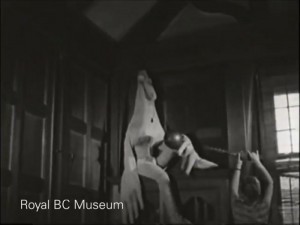
"Produced as a gift to Dorothy Burritt's husband, filmmaker Oscar Burritt (who was working in Toronto at the time), this is an offbeat study of life at their Vancouver apartment -- suite 2, 1960 Robson Street. The camera explores the apartment and the household memorabilia, and Dorothy is seen sitting for a portrait by painter Peter Bortkus. Later some friends drop by for a screening of Sacha Guitry's film Pearls of the Crown, followed by a party. Among the guests are Moira Armour, film editor Maureen Balfe, UBC student Stanley Fox, photographer Peter Varley, and an unnamed figure wearing a bird costume. Most of the people shown would have been involved with the National Film Society of Canada (Vancouver Branch). Suite Two won honourable mention (amateur category) at the first Canadian Film Awards in 1949." (BC Archives)
The film was restored in 1986 by the British Columbia Archives.
"Scenes of a wedding party held in a large garden. There is a large marquee, the bride and groom are mingling with guests and there are a large number of bridesmaids. Some of the guests are extremely well-dressed - furs and big hat for one woman - and the priest is shown talking to some of the guests. As the couple depart, the guests assemble on the house steps to throw streamers. Other scenes show a family in the garden, with the children playing ring-a-ring-a-roses." (NWFA Online Database)
"Family scenes of playing in the garden at Westworth, Cockermouth. The children play in the garden with a trolley, an elderly couple walk in the grounds and the family pose for a group photograph." (NWFA Online Database)
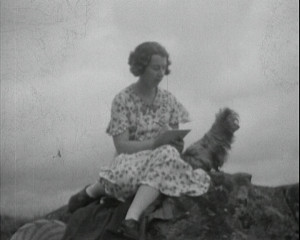
"Amateur filmmaker and cinema historian H.A.V. Bulleid employs rapid montage and a sense of foreboding in this rural tragedy set in the Welsh countryside. On farmland in rural Wales, where crumbling farm buildings reflect the rural desolation, a young lady spends her holidays wandering the fells with her ever reliable dog. When she meets a young farmhand, a romance develops. But as the girl grows closer to the young man, she pays less attention to her dog. And when the dog is left at the farmhouse as the pair goes rock-climbing, tragedy ensues. Sensing a problem, the dog searches the fells as day turns to night. But will he find his master? And will the young lovers survive?" (EAFA Database)
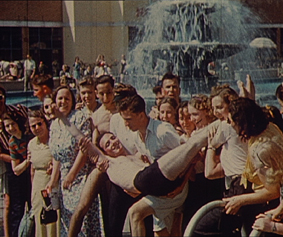
Amateur colour film of a fundraising carnival and summer activities at Clacton-on-Sea in the month before World War II was declared. (EAFA)
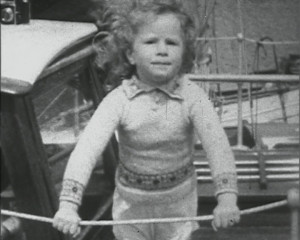
"This film shows the excavation of a 7th-century ship at Sutton Hoo led by Charles Phillips, a fellow at Cambridge." (EAFA Database)
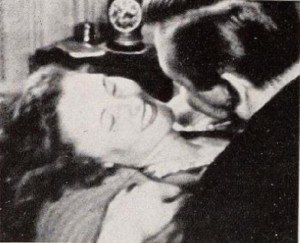
"Novel continuity, beautiful cinematography and a nosegay of feminine charms are the distinctive features of Ten Pretty Girls, produced by Anchor O. Jensen. This expert little drama, made on 8mm Kodachrome, is an excellent example of quality workmanship in that width. The opening scene shows a young man contemplating his address book. He folds a large piece of paper and cuts from it a string of ten dolls, which become the symbols of as many lovely young women. As each doll is torn from the group, a new sequence featuring one of the girls is introduced. A different flower, corsage or bouquet figures in the action as each of the girls is shown in some individual and flattering setting. At the conclusion, the young man has made his choice; he spurns the blondes and brunettes for the favors of a titian beauty." Movie Makers, Dec. 1943, 474.
"Okamoto's heroine was a Japanese girl making a doll as a birthday present for a friend. Pictorial values, backgrounds of the Japanese countryside in spring, and the delicate grain which Cinematographer Okamoto had achieved gave his film distinction." American Cinematographer, Feb. 1935, 78.
"'Tender Friendship,' in 150 feet of 8mm film, was sensational from the photographic standpoint. Its sheer beauty, its poetic rhythm both in story and photography, made it one of the outstanding pictures of the contest" American Cinematographer, Dec. 1934, 365.
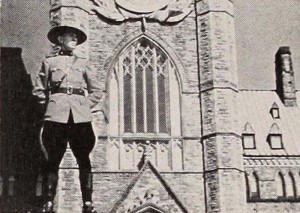
"Sweeping in its conception, stirring in its execution, Then Came the King is a vivid and beautiful epic of honest patriotism. In it, Earl L. Clark has examined the Western way of life, and he has found it good. With elaborate but never exhausting detail, the film traces the history of Canada — and more briefly her American neighbor — from 1800 to the present day. Then, in a world challenged by war and a Canada accused of waning fealty to the Empire, Then Came the King pictures with a magnificent climax the deep and unfaltering affection in which a loyal people hold their rulers. People of all classes and occupations are shown saluting Their Majesties. Sensitively planned and superbly titled, the film very definitely has something to say — and says it with distinction. Viewpoint after viewpoint strikes sensuously on the eye as exactly right for the effect desired. Sequence after sequence marches down the screen with the brave and stirring rhythms of epic poetry. On a few occasions, Mr. Clark's striking imagination has outstripped his straining technical skill, but. from his first frame to his last, the work is stamped unerringly with a fresh and genuine creative spirit." Movie Makers, Dec. 1939, 632.
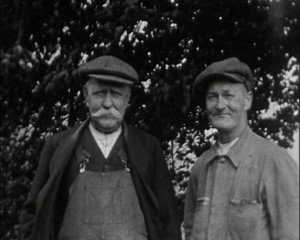
"Local newsreel on events in Thetford filmed by Ben Culey, showing the Palace Cinema, which he owned and where people came to see his local news films." (EAFA Database)
Total Pages: 29